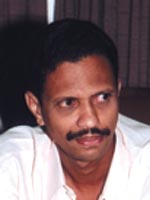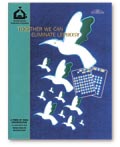| REPORT FROM INDIA |
| Demystifying Leprosy |
| A workshop explores ways to familiarize people with the true nature of the disease. |
| Seeking ways to change mindsets |
| |
| |
Transforming a government program to eliminate leprosy into a people's movement was the goal of the National Consultation Workshop on Advocacy Strategies for the Elimination of Leprosy held in New Delhi June 4-5.
Organized by Dr. S.D. Gokhale (International Leprosy Union), the two-day event brought together an eclectic mix of participants tasked with formulating a strategy for demystifying leprosy and bringing about the social rehabilitation of those affected by the disease.
“Killing the bacillus is not enough. We need to change mindsets,” said Dr. Gokhale.
One starting point is people-centered advocacy, defined by Dr. Amitabh Behar (National Centre of Advocacy Studies) as “a set of organized actions aimed at influencing public policies, societal attitudes and socio economic processes that enable and empower the marginalized to speak for themselves.”
He outlined several steps for effective advocacy, including identifying and framing the issues, mobilizing interested parties, forming and sustaining networks and alliances, and getting media involved.
For Razia Ismail Abbasi (India Alliance for Child Rights), the issue was why such a workshop was necessary in 2004, 20 years after she had become involved in a similar campaign to change attitudes toward leprosy, and despite the proven effectiveness of multidrug therapy in the interim.
The reality, she said, is that leprosy is “not just a bacillus that a combination of drugs can defeat; it is as much a social condition with the power to irrevocably afflict a life.”
Where the role of media was concerned, there was general agreement that the broadest possible definition of the term be used, to allow messages to be targeted and delivered in the most appropriate format.
Shamsher S. Bahadur (The Leprosy Mission Media Center) said that TLM campaigns were coordinated across a whole range of media, and use a “building-block system” in accordance with specific local conditions. The resulting media mix features a combination of mass media (radio and television), interpersonal communications (use of influential community figures), music, theatre, posters, billboards, leaflets, T-shirts, badges and keyrings. In particular, interpersonal communications plays an important role in areas where hardly any mass media are available.
Among the mass media, radio was seen as having the broadest reach, although, as Julian Parr (BBC World Service Trust) pointed out, people only listen to what is local, in their language and has relevance to their lives. Given India's profusion of tongues, translating a leprosy campaign into different languages is thus time consuming and costly. As for the impact of a campaign, the BBC's research showed that its sustainability directly correlates to the amount of time it runs. “The lesson is that you have to keep hammering away at the message,” he said. However, this does not preclude innovative approaches. “Social messaging can be entertaining,” he added. |
| |
| The purpose of the media should be to motivate rather than to educate. |
| |
Where the print media are concerned, the workshop heard that a new role for newspapers was evolving in the area of civic journalism, and that this could provide opportunities for coverage of more social issues, such as leprosy. But participants were reminded that newspapers were commercially driven, required articles that bore the stamp of authenticity and that were suitably packaged for the readership.
On the subject of presentation, Dr. Mohan Agashe (actor, theatre director, psychiatrist) said the purpose of the media should be to motivate rather than educate, “to stir curiosity and bring people to the level where they want to be educated.” Make leprosy the subtext not the text, he said. “Tell a story while giving an injection.”
Group sessions and open debate were also a source of insights and ideas.
In seeking to dispel myths and change mindsets, Dr. H. Srinivasan (Indian Journal on Leprosy) suggested it was sometimes better to work with deeply entrenched belief systems rather than trying to overturn them. “If somebody tells you he was fated to get leprosy, it's no good telling him it has nothing to do with fate. Why should he believe you? Instead, agree that it probably was fate, but that it was also fate that he came to you to be cured with MDT.” |
| |
 |
| |
| Mahendra Shinde |
| |
Another point that the seminar underscored was that in order to reach the broader community, it was necessary to employ the right people for the job. Medical people can't run social programs. These should be left to people who understand the community at large.
The session also emphasized the important role that cured persons can play in speaking out about the disease and assuming a leadership role in NGOs and other organizations. Mahendra Shinde (Bombay Leprosy Project) suggested this was easier said than done, recalling how he had applied for a government position advertised as giving priority to a person affected by leprosy, only to find this was not so.
In closing the conference, Dr. Gokhale pledged various follow-up activities, including creating a resource center on leprosy, identifying spokespersons in hyper-endemic districts, reviewing discriminatory laws, and championing the role of cured persons at the center of any initiative.
“We must recognize this hurts the pride of this country,” he said. |
| |
| |
| |
| ‘SOCIALLY RESPONSIBLE’ MEDIA |
| |
In December 2003, 80,000 copies of a booklet entitled Together We Can Eliminate Leprosy were distributed with The Times of India in Bihar and Jharkhand. In an area with a high rate of illiteracy, the idea was to target the educated decision-makers who form the paper's readership and who have an influence on society and a positive role to play.
Explains Gautam Chatterjee of Times Response, who worked closely on the project, “First you have to reach the reachable, and then, through them, those who are not easily reached.”
Aimed at the lay person, the 16-page booklet gives an overview of the leprosy situation at the global and national levels, contains messages from the chief ministers of Bihar and Jharkhand, and deals with both the medical and social aspects of the disease. It was produced in conjunction with the WHO, with technical input provided by the National Leprosy Eradication Program (NLEP). |
| |
 |
| |
Even among the educated, many people do not have a clear understanding of the disease, says Chatterjee's colleague, Harnam Shankar.“The upper classes have a perception that leprosy only affects the ignorant, who need to be quarantined. We wanted to generate awareness among them, try and sensitize them, and so influence people down the line.”
Although TOI was publishing something on leprosy for the first time, it has previously produced booklets on hepatitis B, polio and HIV/AIDS, and also compiled a directory of doctors in Bihar and Jharkhand.
“As a media house, we have a social responsibility,” says Chatterjee.
“Basically, our job is disseminating information. But at the same time, if we are able to disseminate information that society actually needs - about disease, for example - then I think that is also our role.”
Reaction has been positive, with a number of people saying they had not been aware that the disease was curable, for example. “It showed that our perception that influential members of society did not know that much about leprosy was correct, and that targeting them was the right thing to do,” said Shankar. |
| |
One man who was closely involved in the booklet's production, and has made full use of it since, is Dr. Rajan Shukla, NLEP's state coordinator for Bihar.
“The aim of the booklet was not to have people come and join us, but promote attitudinal change,” he says. “In the past, it was important to promote awareness generation among patients; today, with the success and availability of MDT, this is less of a priority. Now is the time to focus on members of the general public; their attitudes make or break stigma.”
In an illiterate society, every literate person is an influencer, he points out.
“When literacy levels are low, people believe what others say, because they can't read about it for themselves.
Therefore, the literate have a responsibility to spread awareness.”
In addition to the copies distributed with the newspaper in Bihar and Jharkhand, another 10,000 copies were printed, and these have proved very handy as a promotional tool to give to district officials, legislators, industry federations, as well as banks, which have money for social initiatives. It has also been useful to give to other doctors. Dr. Shukla recalls handing the booklet to six or seven heads of department at Patna Medical College. When they started reading, there was a “pin-drop silence,” he says. “They found out things about leprosy they never knew.” |
| |
|